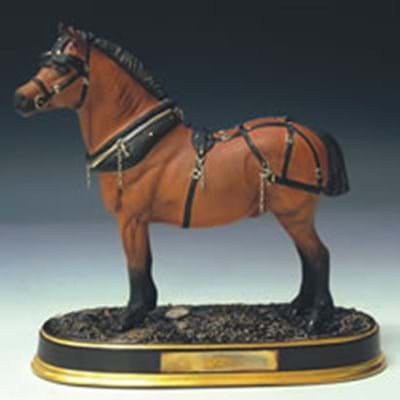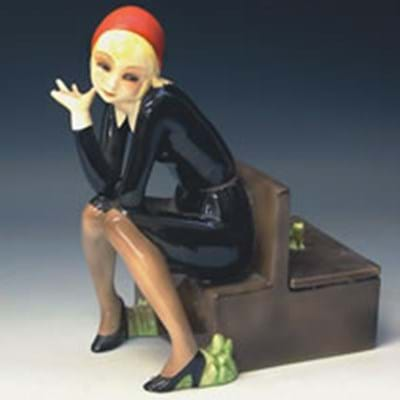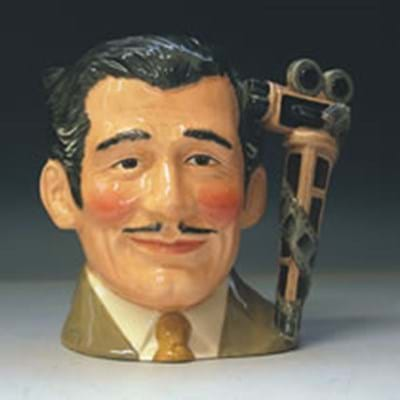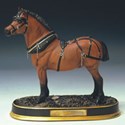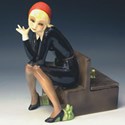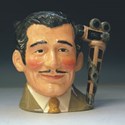The Beswick horse, modelled after a pit pony called Kruger who retired from the Chatterley Whitfield colliery in 1931, set the auction record for Beswick when an example fetched £9500 at Bonhams Bond Street in 2003.
Spirit of Whitfield was never allocated a shape number, but Beswick studio's chief designer, Graham Tongue, is known to have made four models commemorating a royal visit to the colliery in 1987. The original was presented to the Princess Royal, a second fetching £2750 in a 1994 auction and the third horse sold at Bonhams in 2003.
An elderly Staffordshire private vendor consigned a fourth Spirit of Whitfield to Peter Wilson's Cheshire sale. Given the 91/2in (24cm) high horse's auction track record, and the massive private demand for unusual pieces of Beswick, it was no surprise when it stole the limelight.
However, Peter Wilson specialist Chris Large said there was trade speculation as to whether their Spirit of Whitfield was, in fact, the fourth example or a possible unrecorded fifth model.
"Whenever the Beswick factory made a limited edition, they always made extra examples," he explained. "For example, they would keep a display piece and they would probably have made extra models in case one was dropped."
Whether or not as a result of such speculation, buyers were reticent about leaving bids - by the morning of the auction only one commission bid had been left and only one telephone line booked.
"Just because one model made nearly £10,000 does not mean that another example is going to make the same money," said Mr Large.
In the event, three or four serious private buyers turned up in person to contest the figure in the room. It was knocked down to one of them at £8500 - the third highest auction price for a piece of Beswick.
The spiralling of Beswick prices has actually posed a problem for some owners. Mr Large says an increasing number of elderly vendors are now dispersing their collections because of the security concern they now pose.
There was also interest at Nantwich in the 26-lot Royal Doulton section which fielded only two casualties. A Royal Doulton Clark Gable character jug, D6709, consigned together with 20 or so other Doulton and Beswick figures from the same source as Spirit of Whitfield, took one of the highest bids at £1750.
"Character jugs have been making noticeably more money," said Mr Large. "This one sold to a collector." Just a fortnight later, another example of this rare jug from the Celebrity Series was sold at Potteries Specialist Auctions for £2050.
Earlier material in the sale's strong ceramics section included two pre-1760 English blue and white porcelain scallop shell pickle dishes.
The first was a 3in (8cm) long dish dating to c.1750 and attributed to either Lunds Bristol or Worcester.
It was painted with a stylised Long Eliza and a diaper pattern border and, despite a crack to the body, took £1300 from a dealer.
The second entry, from a different private vendor, was a Limehouse dish dating to c.1746-48 depicting a blurred Chinese vase.
A private buyer secured it at £1450.
Art Deco figures by Lenci have been strong of late. From the same source as the Lunds pickle dish came a colourful Lenci figure of a languid young lady seated on a lidded box.
Although the box was damaged and the lady missing two fingers, the 9in (23cm) high figure took £2500. The ceramics section also included two turn-of-last-century Minton plaques by J.E. Dean which took multiple estimates of £1600 and £3050 - the reason being their subject of cockerels and the determined private bidder being a breeder of the fowls.
Elsewhere, while there was little change in demand for shipping-style brown furniture, some healthy prices were realised for quality reproduction pieces.
A Chippendale style mahogany extending D-end dining table with a matching set of ten dining chairs found a buyer at £5200.
Buyers were not deterred by the later additions to two mahogany tall boys, possibly Irish, which nevertheless looked the part.
Peter Wilson specialist Andrew Turner reckoned their backboards and feet were new and that the fronts had been polished, although the drawers and carcasses were 18th century.
Given the selectivity of the furniture market, Mr Turner felt winning bids of £2100 and £1500 represented "quite extraordinary money".

